
PREV ARTICLE
NEXT ARTICLE
FULL ISSUE
PREV FULL ISSUE
MORE ON LABOR EXCHANGE NOTES
David Gladfelter forwarded the text of an article he'd written about a New Jersey Labor Exchange note titled "Scrip of an 1890s Utopian Movement". Thanks! Here's an excerpt.
-Editor
The so-called “gay nineties” was actually a period of economic hard times for American farmers and industrial workers. Employment shrank and credit became tight. Many turned to cooperative ventures as a way to make ends meet. They believed that through collective ownership and control, they could earn their living without having to rely on employers, financiers and middlemen to provide them with work. Mutual benefit, rather than profit, was to be the goal of the cooperative movement. To pursue this goal, a Missouri farmer, Giovanni B. DeBernardi (1831-1901), organized the Labor Exchange in 1889 at Independence. DeBernardi, born in Italy, had lost most of his farm to foreclosure during the Panic of 1873. Through lectures, promotional tracts and publication of a newspaper, DeBernardi drew a respectable number of adherents to his organization. By 1896 it had an estimated 6,000 members in 135 chartered branches throughout 32 states. It ultimately grew to more than 15,000 members in 311 branches, including one in Toronto, then declined and went out of existence after the turn of the century. (In Freedom, Kansas, an actual socialist colony based on DeBernardi’s principles was organized on 160 acres of farmland, but this colony was not formally associated with the Labor Exchange.) According to Gordon S. Watkins, a labor economist, this is how the exchange system worked:
Members of the association were privileged to bring to the exchange any commodity they desired, and to receive payment in the form of a labor check for an equivalent value in the local wholesale market, where goods would be purchased at retail prices. Nonmembers could trade at the exchange either by use of labor checks or legal money. The check illustrated is good for one-tenth of a “unit” of labor. In his studies, Steve Whitfield says that a “unit” was worth a day’s labor and that the checks were issued in denominations of 1/100, 1/20, 1/10, ¼, ½, 1, 2, 5, 10 and 20 “units”. Presumably that meant that, say, a carpenter member who spent a day making a cabinet would receive a 1-unit check for bringing the cabinet to the exchange, and could either hold the check as money or spend it by taking out commodities on which other members had worked an equivalent amount of time to produce. There may even have been a “shop book” for setting standard values for the commodities, but this is not known.
Bruce W. Smith submitted these thoughts on Labor Exchange notes, along with images of two different types of the notes from Cincinnati, OH. The other two notes illustrated here are mine, from last week's E-Sylum.
-Editor
I wrote two major articles on these notes which were published in Bank Note Reporter. The first was in the February 1996 issue. The second was published sometime after March 1997. I have been recording Labor Exchange notes since the 1970's because the headquarters was in Missouri. There is a note on the branch at Marshall, MO but none are known for Branch #1 at Kansas City, MO. I have recorded notes on 48 different branches (49 including the previously unknown branch in last Sunday's E-Sylum) in 17 states. Three types of notes have been recorded in various sources:
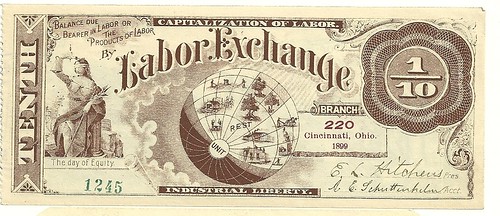
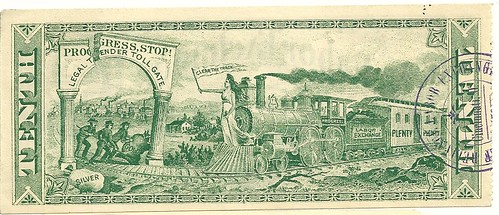
1) Obv: globe center; seated woman left end. Rev: train approaching marble arch.
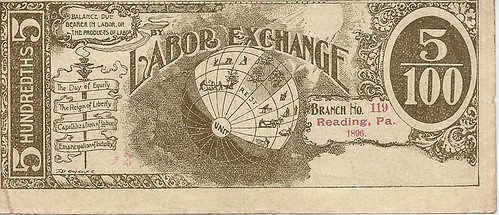
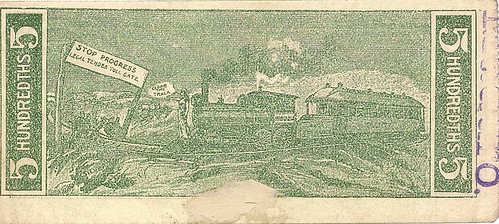
2) Obv: globe center; banner left end. Rev: train approaching wooden arch.
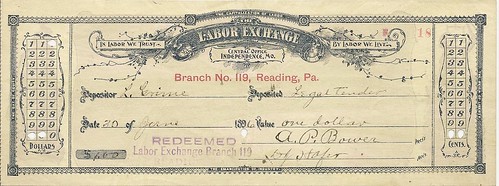
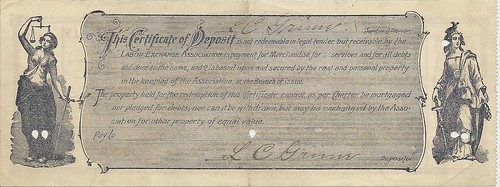
3) No vignette; punch boxes for dollar amounts left end, cent amounts right end. In 2005 I purchased on eBay a previously unknown type (to me at least) of Labor Exchange note, smaller than the others, printed in blue on the front and orange on the back. Obverse has workman with globe on his shoulders left, hand holding a torch right. No vignette on back. The note is for 10/100 and is from the "Self Reliance Branch No. 220 of the Labor Exchange" at Cincinnati, Ohio. The undated note calls itself a "Balance Check" or "Due Bill".
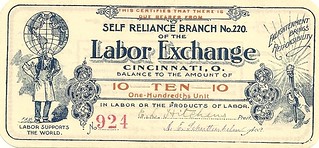
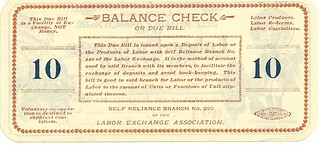
4) "Balance Check" or "Due Bill" Note Probably something over 90 percent of Labor Exchange notes are the globe and train type. The punch box type is much rarer. The Due Bill I have is the only one I have ever seen of that type. Some of the state catalogs of obsolete notes list these Labor Exchange notes. They are not in the Haxby catalog of obsolete notes because Haxby decided to list only BANK notes and not scrip. I talked to him awhile back. He's thinking of doing another edition of the obsolete book. It has been out of print for years and sells now for $600 to $1000. Krause recently released a version of the original book on CD. Listing just the scrip would require another set of volumes.
Thanks! I'd never seen the Due Bill form, and until I purchased the punch box one, I'd never seen one of those, either. Steve Whitfield also kindly forwarded to me his list of known Labor Exchange notes. Although Bruce Smith didn't have a listing for the Reading, PA branch, Steve did. Thanks. I'm still very much looking forward to Neil Shafer's upcoming book.
-Editor
Bruce Perdue of the Central States Numismatic Society adds: The upcoming Neil Shafer book on emergency scrip issues of 1893 to 1915 is another book project that benefited from a CSNS numismatic book grant.
Steve Whitfield also sent the following article for republishing here. We don't have the image of the note handy, but it's an interesting story nonetheless, and helps define the timetable of when these notes were in use.
-Editor
Labor Exchange Scrip;
My article in the Nov / Dec issue of Paper Money about the Labor Exchange branch system of the 1890s elicited several interesting responses from readers. It also turned up a dynamite note in a new denomination. Friend Larry Falater sent me a copy of the note illustrated here. Nothing like it had been seen before, to my knowledge. The note was issued by surely one of the last branches to be organized. The Labor Exchange organization had pretty much died out by the turn of the twentieth century, although some branches continued operations into the teens. DeBernardi, the founder, had died in 1901. This note proves that branches were still being chartered as late as 1905. Branch # 335 of Detroit Michigan (the previous high charter was #318.) was self named “The Christian Industrial Exchange”. This note is an unredeemed certificate of deposit for 3 units of labor. It was apparently used in an attempt to recruit new members to the exchange. It is specifically “not redeemable in legal tender”, although legal tender could be deposited at the exchange and later be redeemed as labor units for goods or services. The back of the note explains why the note was still “in circulation” and advertises services provided by the exchange to its members.. The purpose of the organization was “both cooperative and benevolent; consistent with the true principals of Christian brother-hood.”. The note boldly states “THE CAPITALIZATION OF LABOR IN THE NAME OF CHRIST”. The branch was located at 15-17 Wilcox ST., in Detroit. And the telephone # was M.4401-J. (Collectors from Detroit may want to try this number to see if the Exchange is still there.) The Heritage paper money sale, in January, included one of the rare certificates of deposit on Branch #277, Gray Cloud Island, Minnesota. Ms. Harriet Mavis had deposited $2.50 in US legal tender in November, 1897. These are attractive notes/CDs with great end vignettes on the back. I, of course was outbid on the note which went for $345! Aari Jacob reported acquisition of a Labor Exchange seal from Branch #14, at Dilley, Oregon and several others reported unlisted notes, or submitted spelling error changes. Meanwhile, Hugh Shull turned up a previously unreported, but predicted, piece on Salina Kansas that I was happy to add to my collection. So thanks to the responders and please let me know if you turn up any new Labor Exchange notes or related items.
Many thanks to everyone who responded with information on these interesting notes.
-Editor
To read the earlier E-Sylum article, see:
THE LABOR EXCHANGE NOTES OF GIOVANNI DEBERNARDI
(www.coinbooks.org/esylum_v15n51a15.html)
The Numismatic Bibliomania Society is a non-profit organization promoting numismatic literature. See our web site at coinbooks.org. To submit items for publication in The E-Sylum, write to the Editor at this address: whomren@gmail.com To subscribe go to: https://my.binhost.com/lists/listinfo/esylum All Rights Reserved. NBS Home Page Contact the NBS webmaster 
|